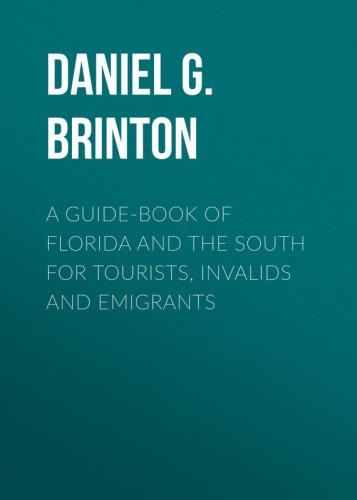For the whole of this distance a glance at the map will show that the coast is lined by long, narrow inlets, separated from the ocean by still narrower strips of land. These inlets are the “lagoons.” The heavy rains wash into them quantities of sediment, and this, with the loose sand blown by the winds from the outer shore, gradually fills up the lagoon, and changes it into a morass, and at last into a low sandy swamp, through which a sluggish stream winds to its remote outlet. Probably the St. John river was at one time a long lagoon, and probably all the land between the ridge described and the eastern sea has been formed by this slow process.
The southern portion of the peninsula is also very low, rarely being more than six feet above sea level, but its slope, instead of being northward, is generally westward. Much of the surface is muddy rather than sandy, and is characterized by two remarkable forms of vegetable life, the Everglades and the Big Cypress.
The Everglades cover an area of about 4,000 square miles, and embrace more than one half of the State south of Lake Okee-chobee. They present to the eye a vast field of coarse saw-grass springing from a soil of quicksand and soft mud, from three to ten feet deep. During the whole year the water rests on this soil from one to four feet in depth, spreading out into lakes, or forming narrow channels. The substratum is a limestone, not tertiary, but modern and coralline. Here and there it rises above the mud, forming “keys” or islands of remarkable fertility, and on the east and south makes a continuous ridge along the ocean, one to four miles wide, and from ten to fifteen feet high, which encloses the interior low basin like a vast crescentic dam-breast.
Lake Okee-chobee, 1,200 square miles in area, with an average depth of twelve feet, is, in fact, only an extension of the Everglades.
South of the Caloosa-hatchie river, between the Everglades and the Gulf, extends the Big Cypress. This is a large swamp, fifty miles long and thirty-five miles broad. Here the saw-grass gives way to groves of cypress trees, with a rank and tangled undergrowth of vines. The soil is either bog or quicksand, generally covered one or two feet deep with stagnant water. The sun’s rays rarely penetrate the dense foliage, and on the surface of the water floats a green slime, which, when disturbed, emits a sickening odor of decay. Crooked pools and sluggish streams traverse it in all directions, growing deeper and wider toward the Gulf shore, where they cut up the soil into numberless segments, called the Thousand Islands.
The whole of this southern portion of the peninsula lies on a modern, coral formation. The crescent-shaped ridge which forms the eastern and southern boundary of the Everglades, commences north of Key Biscayne Bay, and sweeps southwest to Cape Sable. From the same starting point, another broken crescent of coralline limestone, but many miles longer, extends to the Dry Tortugas, forming the Florida Keys. And beyond this again some five or six miles, making a third crescent, is the Florida Reef. Outside of the Reef, the bottom abruptly sinks to a depth of 800 or 900 fathoms. Between the Reef and the Keys is the ship channel, about 6 fathoms in depth; and between the Keys and the main land the water is very shallow, and covers broad flats of white calcareous mud. Between the coast-ridge and Lake Okee-chobee, the “Keys,” which are scattered through the Everglades, are disposed in similar crescentic forms, some seven regular concentric arcs having been observed. They are all formed of the same character of coral rock as the present Reef and Keys, and undoubtedly owe their existence to the same agency. Each of these crescents was at one time a reef, until the industrious coral animals built another reef further out in the water, when the older line was broken up by the waves into small islands. Thus, for countless thousands of years, has this work of construction been going on around the extremity of the tertiary back bone ridge which at first projected but a short distance into the waters.
What, it may be asked, has impressed this peculiar and unusual crescentic shape to the reefs? This is owing to the Gulf Stream. This ocean-river rushes eastward through the Straits of Florida at the rate of five or six miles an hour, yet it does not wash the reef. By some obscure law of motion, an eddy counter-current is produced, moving westward, close to the reef, with a velocity of one or two miles an hour. Off Key West this secondary current is ten miles wide, with a rapidity of two miles per hour. Its waters are constantly whitened by the calcareous sands of the reef – the relics of the endless conflict between the waves and the untiring coral insects. The slowly-built houses of the latter are broken and tossed hither and thither by the billows, until they are ground into powder, and scattered through the waters. After every gale the sea, for miles on either side of the reef, is almost milk-white with the ruins of these coral homes.
Конец ознакомительного фрагмента.
Текст предоставлен ООО «ЛитРес».
Прочитайте эту книгу целиком, купив полную легальную версию на ЛитРес.
Безопасно оплатить книгу можно банковской картой Visa, MasterCard, Maestro, со счета мобильного телефона, с платежного терминала, в салоне МТС или Связной, через PayPal, WebMoney, Яндекс.Деньги, QIWI Кошелек, бонусными картами или другим удобным Вам способом.
